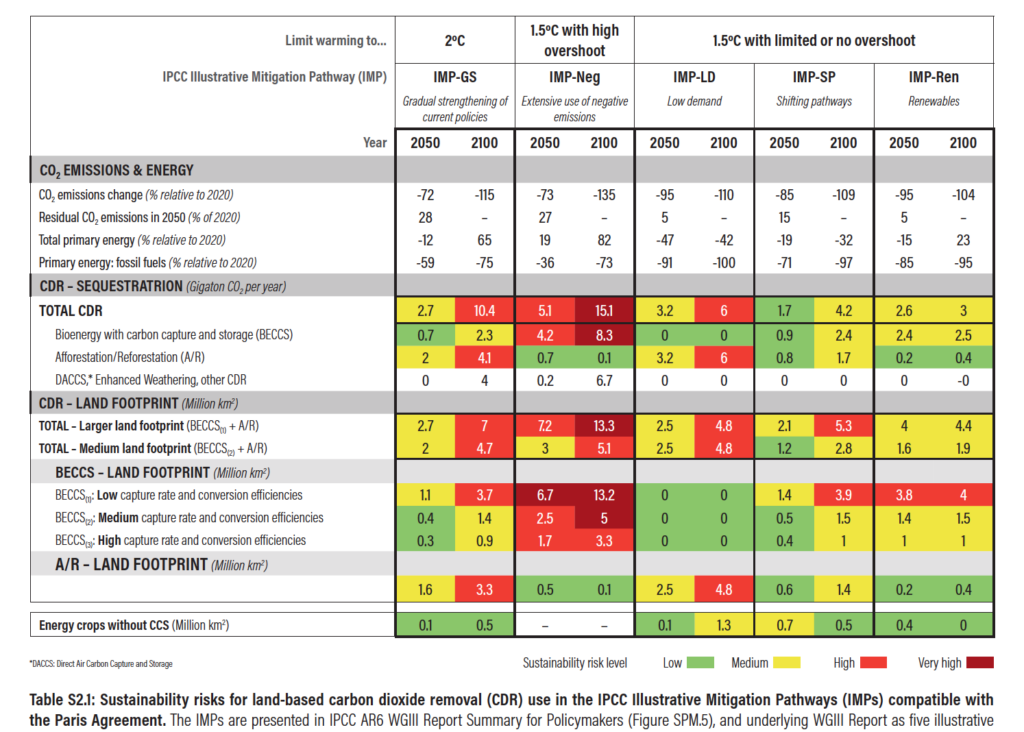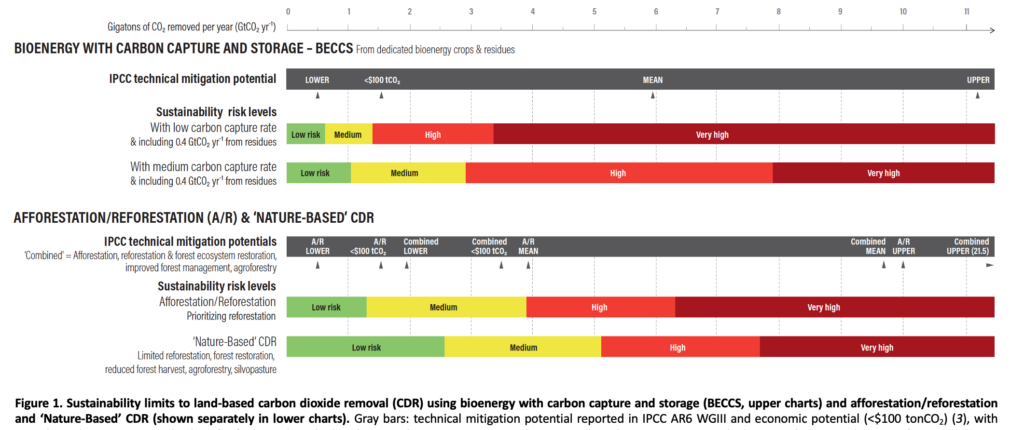Guest post: Heavy use of CO2 removal would trigger high sustainability risks – Carbon Brief
[ad_1]
Many pathways to staying below 1.5C delay deep cuts in carbon dioxide (CO2) emissions and rely instead on huge amounts of CO2 removal (CDR) later this century.
Land-based CDR is used extensively in the 1.5C pathways presented by the Intergovernmental Panel on Climate Change (IPCC) and also features heavily in the climate plans of many governments and businesses.
Yet the large-scale deployment of land-based CDR could come with major challenges. These include significant ecological and societal risks – particularly to biodiversity loss, food security, freshwater use and human rights, among others – which have not been comprehensively assessed.
In our new paper, published in Science, we assess the level of sustainability risks that could be triggered by the use of various different land-based CDR techniques, such as bioenergy with carbon capture and storage (BECCS) and afforestation and reforestation (A/R).
We show that risks are triggered at much lower levels of deployment than previously thought. Moreover, many of the “Paris aligned” 1.5C pathways presented by the IPCC would exceed the CDR sustainability limits defined by our evaluation.
CDR deployment in mitigation pathways
Many mitigation pathways assessed by the IPCC envisage large deployments of CDR throughout the 21st century.
This is significant because, although the IPCC is not “policy prescriptive”, these pathways – and the policy options within them – strongly shape the “solution space” as seen by policymakers when considering how to meet the goals of the Paris Agreement.
The use of CDR is particularly widespread in the pathways labelled by the IPCC as “1.5C with high overshoot”. In these pathways, emissions cuts are not fast enough to avoid breaching the carbon budget for 1.5C and global temperatures temporarily overshoot the 1.5C limit, before extensive use of CDR brings temperatures down later this century.
Within these pathways, CDR is deployed up to 2050 to help compensate for a slower transition away from fossil fuels, to reduce net emissions. When emissions reach net-zero, CDR is being used to counterbalance large remaining residual emissions. Beyond this point, it is used to draw-down global temperature after exceeding 1.5C.
This type of pathway is typified by the IPCC’s “Neg” illustrative mitigation pathway. Here, – some 5.1bn tonnes of CO2 (GtCO2) is taken out of the atmosphere using CDR in 2050 and 15.1GtCO2 in 2100.
In this pathway, one of five outlined in the IPPC’s sixth assessment report (AR6), primary energy from fossil fuel drops only 36% below 2020 levels by 2050 and 73% by 2100, relative to 2020.
This CDR and emissions profile is in sharp contrast to the IPCC’s “Ren” pathway – which relies on rapid scale-up of renewable energy – primary energy from fossil fuel falls 85% by 2050 and 95% by 2100, relative to 2020. (IMP-Ren)
This means that this renewable energy pathway has much lower reliance on CDR, which is only used to take 2.6GtCO2 out of the atmosphere in 2050 and 3GtCO2 in 2100.
Sustainability limits
The large amounts of land-based CDR in many of the pathways assessed by the IPCC come with significant implications in terms of sustainability, with the potential for serious impacts on human livelihoods and food security.
Yet the IPCC report does not comprehensively assess the environmental feasibility of the scenarios, nor their associated sustainability risks. Nor does it put a figure on the scale of CDR that could be deployed without triggering major impacts.
To address this gap, we quantified the sustainability limits to the widespread deployment of BECCS, A/R and “nature-based” CDR, which includes limited reforestation, forest restoration, reduced forest harvest and agroforestry.
To do so, we draw from recent studies that give greater attention to the ecological, biological and societal impacts of land-based CDR.
Based on these studies, we calculated the levels of CDR deployment that would trigger “low”, “medium”, “high” and “very high” risks for sustainability. These risk levels are colour-coded from green through to dark red, for each type of land-based CDR in the figure below.
Reading from left to right, the figure shows increasing levels of CDR deployment in terms of GtCO2 removed per year. The grey bar shows the range of “technical mitigation potential” for each technique, as currently assessed by the IPCC. The upper end of this is the largest amount that could theoretically be deployed, if barriers to rapid scale-up, constraints on feasibility and sustainability risks are not taken into account.
The figure shows that sustainability risks start well below the technical mitigation potential.
For BECCS, the IPCC reports an average technical potential of 5.9GtCO2 per year. Yet we find that deploying more than 1.2GtCO2 of BECCS per year would tip over from “low risk” into “medium” or higher risk levels.
(This figure is based on BECCS plants capturing a “medium” share of their associated CO2 emissions, below 70%. For a “low” capture rate below 50%, the low-risk threshold drops to just 0.7GtCO2 per year.)
Correspondingly, BECCS would cross the high sustainability risk threshold (shown in red) if used to remove 1.3GtCO2 with a low capture rate – or 2.8GtCO2 with a medium rate.
Even these limited levels of BECCS assume significant bioenergy policy reforms that governments have not yet addressed. These include addressing gaps in emissions accounting and ensuring bioenergy is not causing deforestation, either directly or indirectly.
For A/R, the IPCC average technical potential is 3.9GtCO2 a year. Our research shows that associated sustainability risks remain low or medium below 3.8GtCO2 per year, with high risks beyond that point.
We find that nature-based CDR (which includes limited reforestation) carries the lowest sustainability risks. Deployment would trigger high risks beyond 5.1GtCO2 a year (including 3.8GtCO2 per year of non-monoculture reforestation).
Having defined risk levels for each type of CDR, we then mapped those indicators onto the amount of CDR deployed in each of the IPCC’s five “illustrative mitigation pathways” (IMPs).
(These pathways are: gradual strengthening of climate policy, GS; widespread use of CDR, Neg; low energy demand, LD; shifting pathways towards sustainable development, SP; and heavy use of renewables, Ren.)
Our results, illustrated in the table below, show that the three pathways that limit warming to 1.5C with limited to no overshoot are able to do so without greatly overstepping our sustainability risk thresholds.
In contrast, Neg limits warming in 2100 to 1.5C with high temperature overshoot, but exceeds high and even very high sustainability risk thresholds. The GS pathway only limits warming to 2C and still carries significant levels of sustainability risks.
Reading the table from top to bottom, the first set of rows list the change in CO2 emissions, energy demand and fossil fuel use in 2050 and 2100.
The second set of rows show the amount of each type of CDR deployed in 2050 and 2100, colour-coded according to our sustainability risk levels.
The third set of rows show the amount of land needed for CDR deployment – the land footprint. Again, these are colour-coded according to our sustainability risk levels.

Notably, our findings show that the amount of land needed for CDR in the Neg pathway could reach 7.2m square kilometres in 2050 and 13.3m square kilometres in 2100. For comparison, the land area of the US is just 9.1m square kilometres.
Risk assessment
Our findings suggest there is an urgent need to consider sustainability risks when choosing between different mitigation pathways.
One way to do this would be to define a “sustainable CDR budget”, as the amount of CDR that could be deployed sustainably across all CDR methods.
While our research only considered land-based CDR, alternative CDR options are also likely to come with sustainability and deployment risks, which could limit their potential. These include direct air carbon capture and storage (DACCS) or ocean-based CDR.
Another option would be for scientists to identify Paris-aligned scenarios that do not overstep sustainability limits. Our research suggests that this could be a key priority for the IPCC’s seventh assessment cycle, as well as integrating environmental risks and feasibility throughout the IPCC’s work.
Moreover, our findings suggest that delaying fossil fuel cuts, in the hope that emissions can be drawn down later this century using CDR, would come with high sustainability risks.
If, on the other hand, countries wish to account for biodiversity considerations alongside climate goals, while still limiting temperatures to 1.5C, then they would need to follow a mitigation pathway with more rapid cuts in fossil fuel use, our research suggests.
Many of these pathways include behaviour changes and reductions in energy demand.
Countries could take up our findings in their next nationally-determined contributions (NDCs) under the Paris Agreement, due in 2025. For example, they could address sustainability risks by setting separate, transparent targets for CDR, in addition to headline emissions goals.
They could also aim to limit their reliance on CDR – and its corresponding land footprint – in order to avoid climate actions that have negative consequences for their national biodiversity plans under the global biodiversity framework (NBSAPs).
Sharelines from this story
[ad_2]


